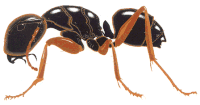Common Ants in Virginia
Carpenter Ants

Carpenter ants are large (10 mm or more) black or brown ants often found in wooded areas. However, they are known to enter homes also, especially in the spring. These ants are most often seen one at a time, and they are by far the largest ants seen on the property. In the spring, you may find large numbers of flying ants. These are the reproductive members of the colony. They indicate the presence of a mature colony nearby, and this is cause for concern. This colony must be found and destroyed immediately because carpenter ants are capable of doing severe structural damage if left untreated. The good news is that can do your own carpenter ant control at a fraction of the cost of professional treatment to take care of this dangerous and costly pest!
Carpenter Ant Control
To find the carpenter ant colony look for the following signs:
- Sawdust Wood shavings, dead ants and old ant cocoons are often piled up outside of the nest.
- Windows Small slit-like openings that carpenter ants cut into damaged wood.
- Swarmers A lot of large, winged flying ants, usually but not always found in the spring. The nest will be found nearby.
- Workers Solitary ants wandering aimlessly, most active at night.
- Clicking If you get close enough, you can actually hear the colony chewing through wood inside your walls.
- Water Damage When you find the leak, the carpenter ants are usually there also.
Fire Ants
 Anyone who has lived in the South during the summer months has already had the unpleasant experience of being stung by fire ants. Fire ants are here to stay, but you don't have to put up with them in your yard or house.
Anyone who has lived in the South during the summer months has already had the unpleasant experience of being stung by fire ants. Fire ants are here to stay, but you don't have to put up with them in your yard or house.
BIOLOGY Fire ants are social insects consisting of a queen, workers, eggs and larvae. The queen lives in a protected nest which may be several feet deep. There may be several satellite nests near the main nest and some nests may have more than one queen. Fire ants usually have two flying swarms each year. After mating the fertilized queen begins a new colony.
- Sawdust Wood shavings, dead ants and old ant cocoons are often piled up outside of the nest.
- Windows Small slit-like openings that carpenter ants cut into damaged wood.
- Swarmers A lot of large, winged flying ants, usually but not always found in the spring. The nest will be found nearby.
- Workers Solitary ants wandering aimlessly, most active at night.
- Clicking If you get close enough, you can actually hear the colony chewing through wood inside your walls.
- Water Damage When you find the leak, the carpenter ants are usually there also.
